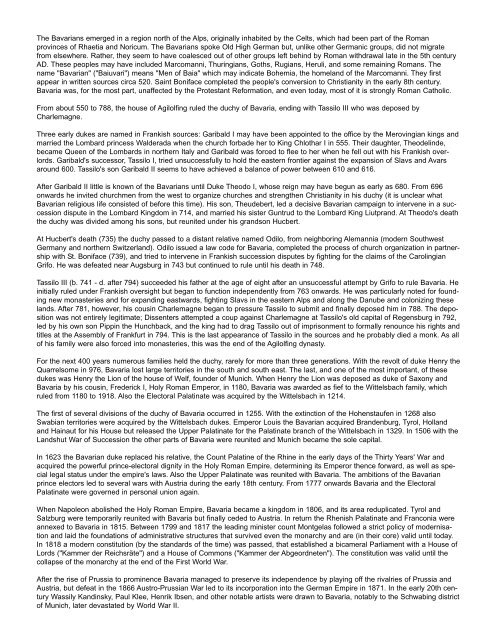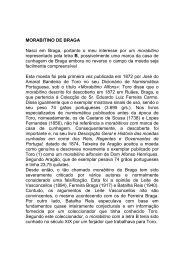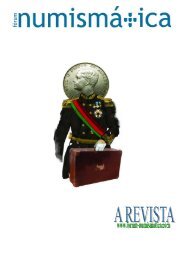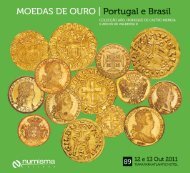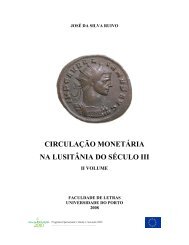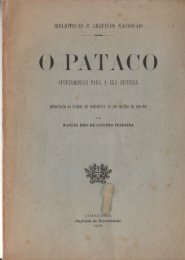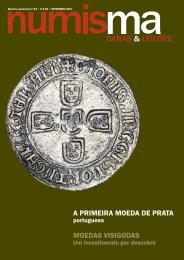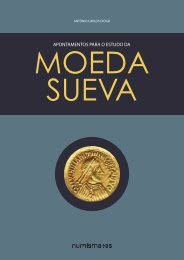Create successful ePaper yourself
Turn your PDF publications into a flip-book with our unique Google optimized e-Paper software.
The <strong>Bavaria</strong>ns emerged in a region north <strong>of</strong> the Alps, originally inhabited by the Celts, which had been part <strong>of</strong> the Roman<br />
provinces <strong>of</strong> Rhaetia and Noricum. The <strong>Bavaria</strong>ns spoke Old High German but, unlike other Germanic groups, did not migrate<br />
from elsewhere. Rather, they seem to have coalesced out <strong>of</strong> other groups left behind by Roman withdrawal late in the 5th century<br />
AD. These peoples may have included Mar<strong>com</strong>anni, Thuringians, Goths, Rugians, Heruli, and some remaining Romans. The<br />
name "<strong>Bavaria</strong>n" ("Baiuvari") means "Men <strong>of</strong> Baia" which may indicate Bohemia, the homeland <strong>of</strong> the Mar<strong>com</strong>anni. They first<br />
appear in written sources circa 520. Saint Boniface <strong>com</strong>pleted the people's conversion to Christianity in the early 8th century.<br />
<strong>Bavaria</strong> was, for the most part, unaffected by the Protestant Reformation, and even today, most <strong>of</strong> it is strongly Roman Catholic.<br />
From about 550 to 788, the house <strong>of</strong> Agilolfing ruled the duchy <strong>of</strong> <strong>Bavaria</strong>, ending with Tassilo III who was deposed by<br />
Charlemagne.<br />
Three early dukes are named in Frankish sources: Garibald I may have been appointed to the <strong>of</strong>fice by the Merovingian kings and<br />
married the Lombard princess Walderada when the church forbade her to King Chlothar I in 555. Their daughter, Theodelinde,<br />
became Queen <strong>of</strong> the Lombards in northern Italy and Garibald was forced to flee to her when he fell out with his Frankish overlords.<br />
Garibald's successor, Tassilo I, tried unsuccessfully to hold the eastern frontier against the expansion <strong>of</strong> Slavs and Avars<br />
around 600. Tassilo's son Garibald II seems to have achieved a balance <strong>of</strong> power between 610 and 616.<br />
After Garibald II little is known <strong>of</strong> the <strong>Bavaria</strong>ns until Duke Theodo I, whose reign may have begun as early as 680. From 696<br />
onwards he invited churchmen from the west to organize churches and strengthen Christianity in his duchy (it is unclear what<br />
<strong>Bavaria</strong>n religious life consisted <strong>of</strong> before this time). His son, Theudebert, led a decisive <strong>Bavaria</strong>n campaign to intervene in a succession<br />
dispute in the Lombard Kingdom in 714, and married his sister Guntrud to the Lombard King Liutprand. At Theodo's death<br />
the duchy was divided among his sons, but reunited under his grandson Hucbert.<br />
At Hucbert's death (735) the duchy passed to a distant relative named Odilo, from neighboring Alemannia (modern Southwest<br />
Germany and northern Switzerland). Odilo issued a law code for <strong>Bavaria</strong>, <strong>com</strong>pleted the process <strong>of</strong> church organization in partnership<br />
with St. Boniface (739), and tried to intervene in Frankish succession disputes by fighting for the claims <strong>of</strong> the Carolingian<br />
Grifo. He was defeated near Augsburg in 743 but continued to rule until his death in 748.<br />
Tassilo III (b. 741 - d. after 794) succeeded his father at the age <strong>of</strong> eight after an unsuccessful attempt by Grifo to rule <strong>Bavaria</strong>. He<br />
initially ruled under Frankish oversight but began to function independently from 763 onwards. He was particularly noted for founding<br />
new monasteries and for expanding eastwards, fighting Slavs in the eastern Alps and along the Danube and colonizing these<br />
lands. After 781, however, his cousin Charlemagne began to pressure Tassilo to submit and finally deposed him in 788. The deposition<br />
was not entirely legitimate; Dissenters attempted a coup against Charlemagne at Tassilo's old capital <strong>of</strong> Regensburg in 792,<br />
led by his own son Pippin the Hunchback, and the king had to drag Tassilo out <strong>of</strong> imprisonment to formally renounce his rights and<br />
titles at the Assembly <strong>of</strong> Frankfurt in 794. This is the last appearance <strong>of</strong> Tassilo in the sources and he probably died a monk. As all<br />
<strong>of</strong> his family were also forced into monasteries, this was the end <strong>of</strong> the Agilolfing dynasty.<br />
For the next 400 years numerous families held the duchy, rarely for more than three generations. With the revolt <strong>of</strong> duke Henry the<br />
Quarrelsome in 976, <strong>Bavaria</strong> lost large territories in the south and south east. The last, and one <strong>of</strong> the most important, <strong>of</strong> these<br />
dukes was Henry the Lion <strong>of</strong> the house <strong>of</strong> Welf, founder <strong>of</strong> Munich. When Henry the Lion was deposed as duke <strong>of</strong> Saxony and<br />
<strong>Bavaria</strong> by his cousin, Frederick I, Holy Roman Emperor, in 1180, <strong>Bavaria</strong> was awarded as fief to the Wittelsbach family, which<br />
ruled from 1180 to 1918. Also the Electoral Palatinate was acquired by the Wittelsbach in 1214.<br />
The first <strong>of</strong> several divisions <strong>of</strong> the duchy <strong>of</strong> <strong>Bavaria</strong> occurred in 1255. With the extinction <strong>of</strong> the Hohenstaufen in 1268 also<br />
Swabian territories were acquired by the Wittelsbach dukes. Emperor Louis the <strong>Bavaria</strong>n acquired Brandenburg, Tyrol, Holland<br />
and Hainaut for his House but released the Upper Palatinate for the Palatinate branch <strong>of</strong> the Wittelsbach in 1329. In 1506 with the<br />
Landshut War <strong>of</strong> Succession the other parts <strong>of</strong> <strong>Bavaria</strong> were reunited and Munich became the sole capital.<br />
In 1623 the <strong>Bavaria</strong>n duke replaced his relative, the Count Palatine <strong>of</strong> the Rhine in the early days <strong>of</strong> the Thirty Years' War and<br />
acquired the powerful prince-electoral dignity in the Holy Roman Empire, determining its Emperor thence forward, as well as special<br />
legal status under the empire's laws. Also the Upper Palatinate was reunited with <strong>Bavaria</strong>. The ambitions <strong>of</strong> the <strong>Bavaria</strong>n<br />
prince electors led to several wars with Austria during the early 18th century. From 1777 onwards <strong>Bavaria</strong> and the Electoral<br />
Palatinate were governed in personal union again.<br />
When Napoleon abolished the Holy Roman Empire, <strong>Bavaria</strong> became a kingdom in 1806, and its area reduplicated. Tyrol and<br />
Salzburg were temporarily reunited with <strong>Bavaria</strong> but finally ceded to Austria. In return the Rhenish Palatinate and Franconia were<br />
annexed to <strong>Bavaria</strong> in 1815. Between 1799 and 1817 the leading minister count Montgelas followed a strict policy <strong>of</strong> modernisation<br />
and laid the foundations <strong>of</strong> administrative structures that survived even the monarchy and are (in their core) valid until today.<br />
In 1818 a modern constitution (by the standards <strong>of</strong> the time) was passed, that established a bicameral Parliament with a House <strong>of</strong><br />
Lords ("Kammer der Reichsräte") and a House <strong>of</strong> Commons ("Kammer der Abgeordneten"). The constitution was valid until the<br />
collapse <strong>of</strong> the monarchy at the end <strong>of</strong> the First World War.<br />
After the rise <strong>of</strong> Prussia to prominence <strong>Bavaria</strong> managed to preserve its independence by playing <strong>of</strong>f the rivalries <strong>of</strong> Prussia and<br />
Austria, but defeat in the 1866 Austro-Prussian War led to its incorporation into the German Empire in 1871. In the early 20th century<br />
Wassily Kandinsky, Paul Klee, Henrik Ibsen, and other notable artists were drawn to <strong>Bavaria</strong>, notably to the Schwabing district<br />
<strong>of</strong> Munich, later devastated by World War II.


